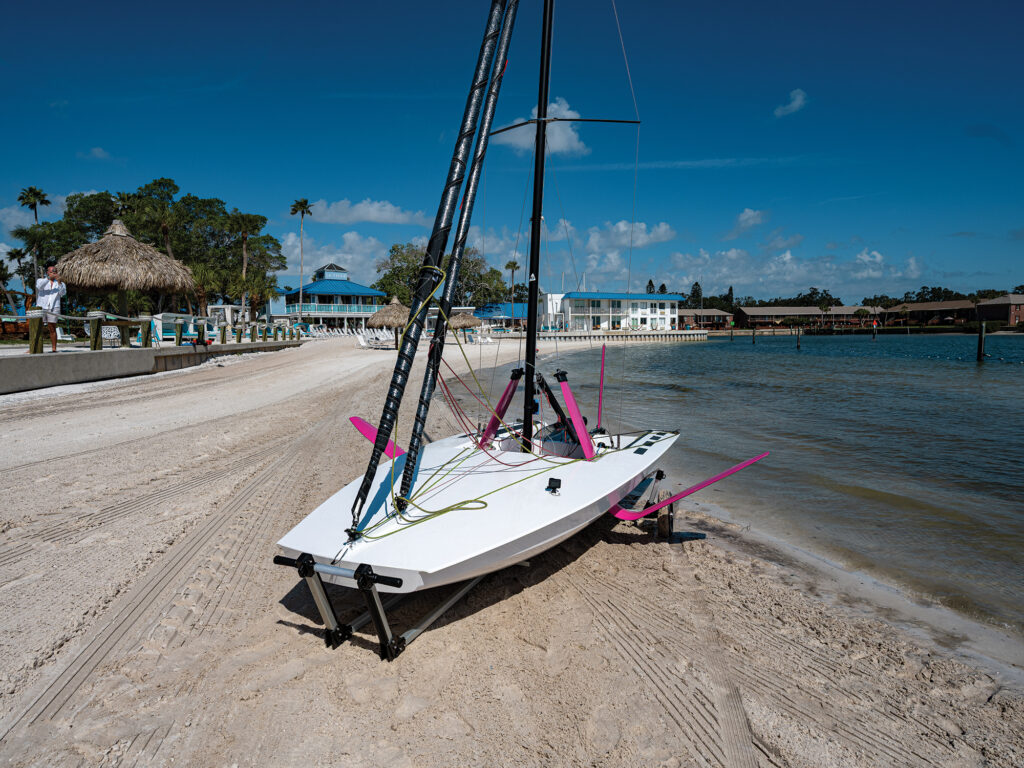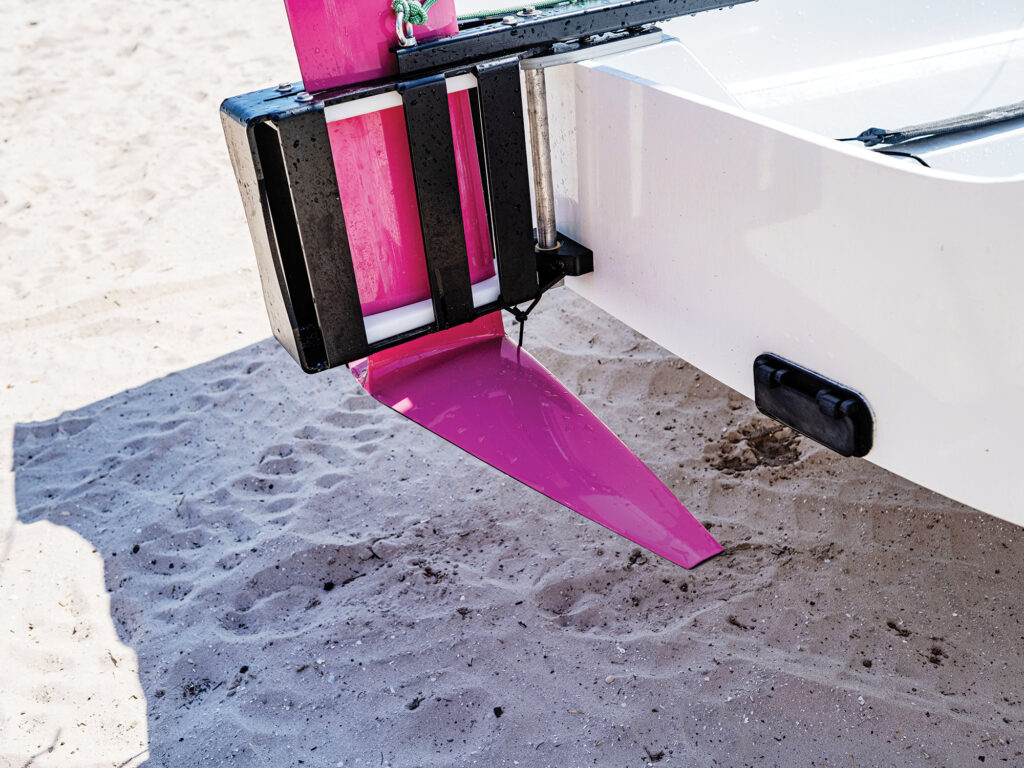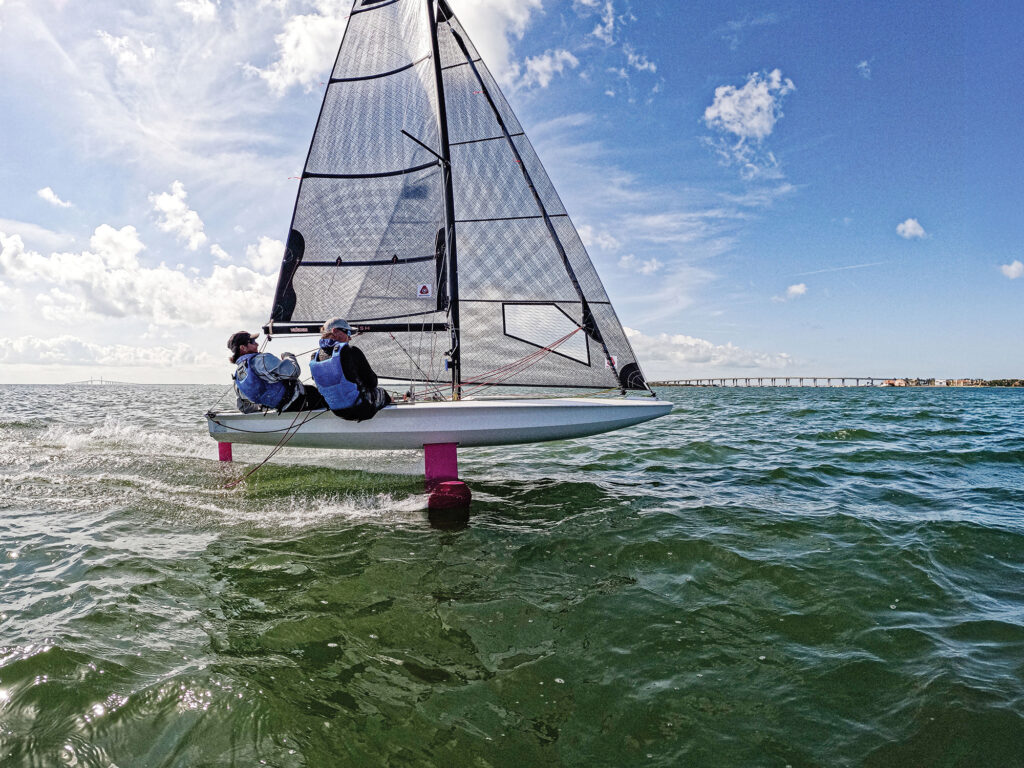SB Television
BirdyFish Race: Your Easy Ticket to Fly
 The BirdyFish (Race Edition) was designed with the goal of providing stable and safe foiling for newbies and fanatics alike.
Walter Cooper
The BirdyFish (Race Edition) was designed with the goal of providing stable and safe foiling for newbies and fanatics alike.
Walter Cooper
For the second day of our 2025 Boat of the Year winter edition in St. Petersburg, Florida, in February, we wake up to the welcome sounds of breeze through palm fronds, knowing that the first sail of the day is a foiling session. On tap is the curious 15-foot BirdyFish, said to be the best entree-to-foiling craft there is. With a distinct scow hull, J-shaped foils, a rudder with an elevator, and a powerful sail plan, the boat is plenty quick. Bonus points there.
But there are also two compelling attributes for wannabe foilers: It doesn’t tip over when it stops, like every other monohull foiler. That means more time sailing, less time swimming. And second, the thing is beginner-proof, which of course means more time sailing, less time fixing or figuring it out. Moth sailors can relate.
.embed-container { position: relative; padding-bottom: 56.25%; height: 0; overflow: hidden; max-width: 100%; } .embed-container iframe, .embed-container object, .embed-container embed { position: absolute; top: 0; left: 0; width: 100%; height: 100%; }Easy flight is the premise of the BirdyFish, whose French designers and builders dabble in the IMOCA space and have figured out how to make this little scow fly so effortlessly. If you can sail a dinghy, you can definitely sail the BirdyFish.
“This boat sails like any other boat,” Hardy Peters, of East Coast Sailboats, says. He’s the boat’s distributor in North Carolina and has been sailing the foils off it since he got his hands on it this past fall. “But once it takes off, you’re following your apparent wind. It’s that simple.”
 The scow dinghy hull, the judges noted, is as comfortable and fun to sail in displacement mode as it is in flight.
Walter Cooper
The scow dinghy hull, the judges noted, is as comfortable and fun to sail in displacement mode as it is in flight.
Walter Cooper
Hardy’s 20-minute presail boat tour is all that the judges require. While the BirdyFish looks complex on its dolly, there actually are not many ropes to pull, and everything is sorted. The J foils slot into casings like leeboards (and can be reversed if need be) and are stored in their upright position, with a lift line leading up to the mast. Once they’re in their slots, the rest of the rigging procedure is cake: Hoist the jib, the gennaker on a furler, and the main up the groove of the carbon rig. Nothing to it.
One important piece of gear, Peters points out, is the bungee keeper that goes from the transom corners to the forward tip of the tiller. “That keeps you honest by keeping the rudder centered,” he says. “The rudder movements with this boat are incremental—I’m talking inches only. The only time you’re pushing the rudder hard is when you’re tacking. The bungee is a safety feature for learning to foil, to dampen the turn and keep you from spinning out. When you get good, you can take it off—if you want.”
One of the biggest challenges for Moth and Waszp sailors is launching, but the BirdyFish comes with no drama. Lower the rudder and foils about a foot, get the boat past the shallow, unfurl the jib to get to deeper water, put the rudder down (at 3 feet of depth), and then push both foils down into their cassettes. Put the keeper bungee over the top, cleat the foil lock-down lines, and you’re off and running. No further adjustments required.
 The J foils and T-foil rudder do not adjust on the fly, but the J Foils can be inverted and reinserted through the casing if need be.
Walter Cooper
The J foils and T-foil rudder do not adjust on the fly, but the J Foils can be inverted and reinserted through the casing if need be.
Walter Cooper
Following this very procedure, Shampain jumps in first with Peters, and they’re promptly off and foiling, hovering only 2 feet above the surface—that’s maximum ride height. There are no mechanical adjustments to foil. It’s all about shifting weight forward, building speed, waiting for liftoff, and then shifting weight aft to let ’er rip.
“I think they nailed it,” Shampain says after he singlehandedly sails the boat in 10 to 12 knots of breeze and flat water. “Without a lot of experience, and having sailed Moths once or twice—barely successfully—I felt pretty successful. It was really intuitive. What was amazing is how much real apparent wind it was making.”
Shampain’s true-wind angle was about 65 to 70 true when foiling, noting that the boat goes upwind just fine with the jib and fairly deep with the gennaker, which would make it a good one-design course-racing boat. When it’s in displacement mode, it delivers the same sensation as a scow. “While it’s not going to be the fastest foiler at the club,” he says, “it will be the most accessible. Adults and youth sailors can experience and learn how to foil in a safe way, where there’s much less risk of crashing and getting hurt. Safe, easy entry to foiling, that’s what this boat is about.”
Ingham, who was rehabbing a shoulder surgery, has his reservations about jumping into the BirdyFish, but after watching Shampain and Peters, he’s keen to give it a go. He’s glad he did.
“The innovation on this boat is like, wow,” Ingham says. “It is an easy foiler, but it’s so responsive to fore-and-aft weight movement, so you can tweak it to get good at it, but at the same time, to get it foiling, you don’t have to be good at it. It’s just kind of automatic.
 Fore-and-aft weight adjustments are essential to getting the BirdyFish to take off and maintain flight as shifting weight changes the angle of attack of the foils.
Walter Cooper
Fore-and-aft weight adjustments are essential to getting the BirdyFish to take off and maintain flight as shifting weight changes the angle of attack of the foils.
Walter Cooper
The boat does, however, have a tendency and ability to turn really fast if you let go over the tiller, he adds. “I felt like I had to hold the rudder really firm and stable, but I also had to drive with a purpose—like if I wanted the boat to go up, I had to make it go up, but when I wanted it to go straight, I had to work really hard to go straight.”
With the class active in Europe, Peters is confident that US class racing is not far behind. He has imported a half-dozen boats, with a vision for a one-design circuit soon. The boat is currently available in a Fun version for $24,000 and a Race version for $25,000, but the next batch, Peters says, will have price increases.
The post BirdyFish Race: Your Easy Ticket to Fly appeared first on Sailing World.
- Home
- About Us
- Write For Us / Submit Content
- Advertising And Affiliates
- Feeds And Syndication
- Contact Us
- Login
- Privacy
All Rights Reserved. Copyright , Central Coast Communications, Inc.